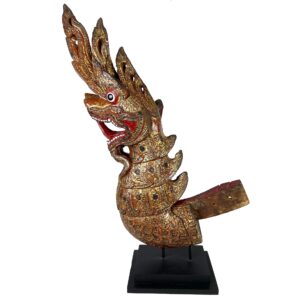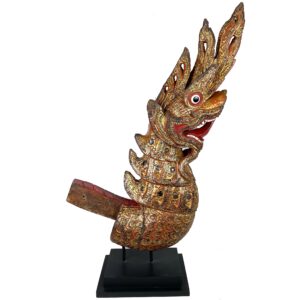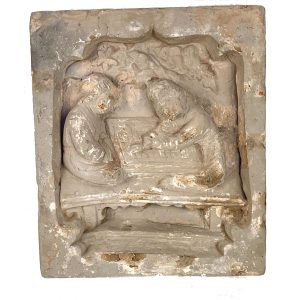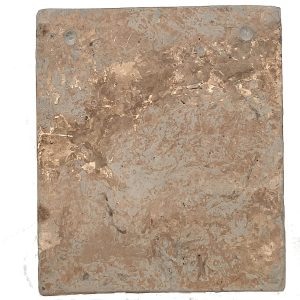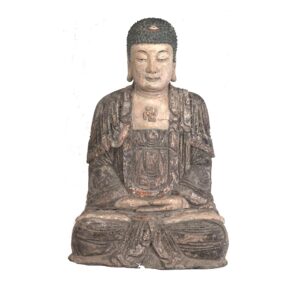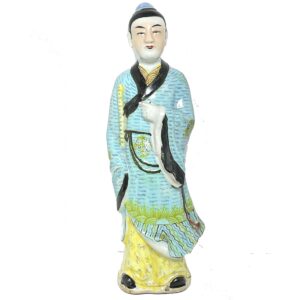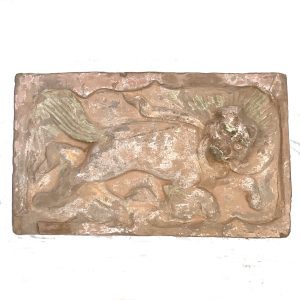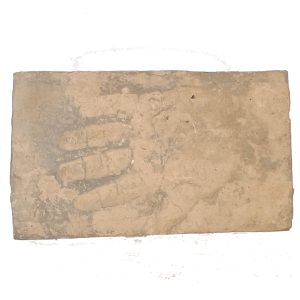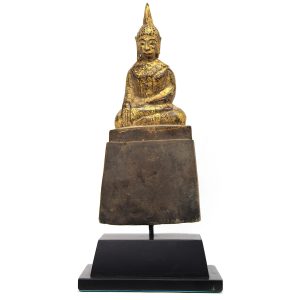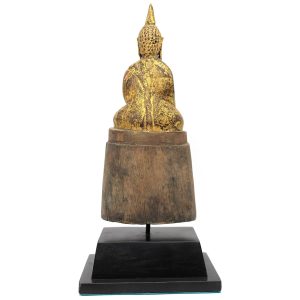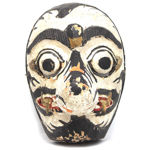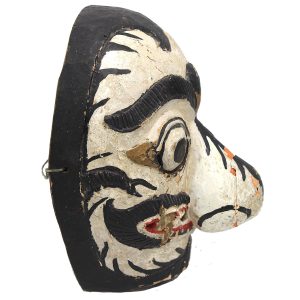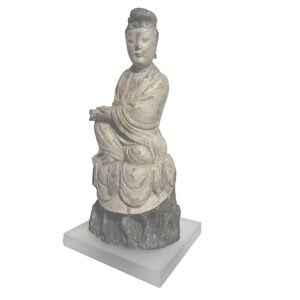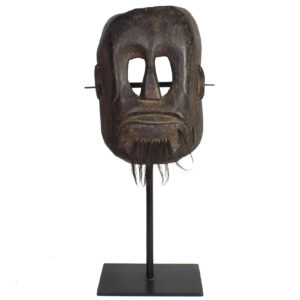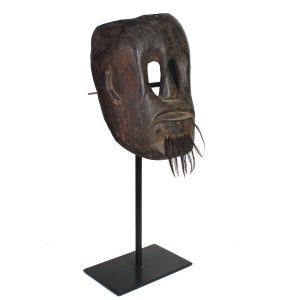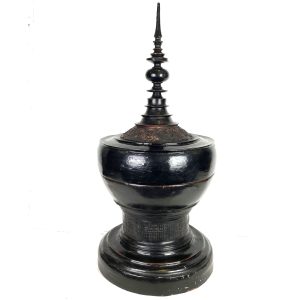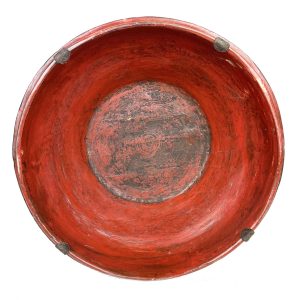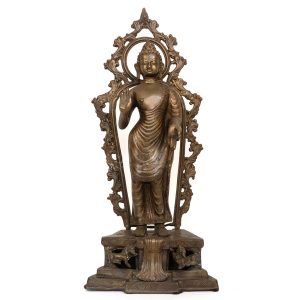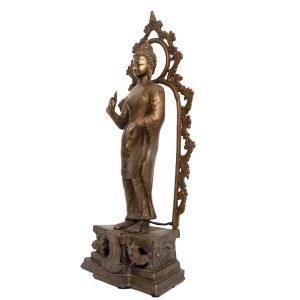Showing 205–216 of 248 results
-


$1,133.00
H: 32″ W: 20″ D: 7.5″ SHIPPING INFORMATION REQUIRED. CONTACT US AT 213-568-3030
This exceptional naga was one of two that comprised a gong stand. Gongs were used in Burma for both ceremonial and musical purposes in religious, state, or secular settings. A protection figure, this naga is a superb carving elaborately decorated with gold lacquer and pigmentation. He opens his mouth wide bearing mother-of-pearl teeth and a curled blood red mouth and tongue to drive away malevolent spirits, also reinforced by the large glaring eyes circled in red. On first glance it is menacing, but its history as a protector of Buddha Shakyamuni make it prized as a fanciful, gleeful guardian. His scales are arched relief designs of mixed lacquer and ash and they are highlighted with inset cut mirrors and green sequin-like glass “jewels.” It is mounted on a museum quality stand and is in excellent condition for its age and use despite missing an ear.
-
Sale!


$495.00 Original price was: $495.00.$395.00Current price is: $395.00.
H: 11” W: 9.5” D: 2” | SOLD
As part of the The Song dynasty cultural expansion, government and public buildings and tombs were built with interior walls decorated with earthenware unglazed mold-made brick tiles. This fanciful vibrant tile with a scalloped frame portrays two people playing a board game called wéiqí which originated in China over 2500 years ago. It is the world’s oldest and most complex board game still played.
-

$0.00
Ht:31.5″ W: 20″ D: 15″ CALL 213-568-3030 FOR AVAILABILITY INFORMATION
This rare magnificent image of Buddha Shakyamuni is represented in meditation position called Ch’ien Pai Yi Hua-shen (the Hundred Billion Human Manifestations) in Chinese, the position the Buddha assume while seeking enlightenment under the Bodhi tree. Thumbs touching at forming a triangle symbolizing the Three Jewels of Buddhism.
-


$295.00
H: 12” W: 4.5” D: 3” | FREE SHIPPING WITHIN CONTINENTAL U.S.
This elegant Chinese Republic Period porcelain is the Taoist immortal Han Xiangzi carrying his auspicious flute dressed in a beautiful blue robe with wide black borders, fine internal decorations and a decorative yellow floral undergarment. On the bottom is the kiln seal. As the patron saint of musicians and florists, it is a great gift for someone who enjoys these pursuits.
-
Sale!


$485.00 Original price was: $485.00.$395.00Current price is: $395.00.
The Song dynasty (960–1279) is considered the most culturally brilliant era in later imperial Chinese history. A massive expansion during this dynasty produced government, public and religious buildings and tombs with walls decorated with earthenware unglazed mold-made brick tiles. Some were purely decorative and others were wishes for happiness and comfort in the deceased’s afterlife…
-
Sale!


$110.00 Original price was: $110.00.$0.00Current price is: $0.00.
H: 7.625″ W: 6.125″ D: 3.375″ | FREE SHIPPING within continental u.s.
Most jauk keras (strong, scary) masks of a giant are often red or orange to reinforce a volatile dance with jerky movements. This jauk manis (good, sweet) mask dance is a more controlled, regulated and enacted with more calm and human movements.
-


$295.00
H: 9” W: 4.25 D: 3.125” | FREE SHIPPING
This mid 20th century Buddha Shakyamuni in Earth Witnessing position is carved in rural Lao style. Covered with gilt, the small rustic and simply carved image follows Lao artistic canons for depicting a Buddha: a curved hairline and high arched eyebrows that meet at the bridge of the nose, distinct hair curls, long ears, and a flame-shaped radiance emerging from his ushnisha. Its very large base is as tall and wide as the image, reflecting Laotian beliefs that a high pedestal reflects a deep respect for the Buddha. A base has been added for display purposes. Authentic old Lao images, even small personal ones like this, are difficult to find.
-


$165.00
Influenced by Islam for centuries, Javanese theater in Indonesia is stylized, didactic and full of central characters said to be cultural and historic icons of morality. Mask drama theater (Topeng Wayang) in Java is dominated by the conservative central Javanese palace courts (kraton) of Surakarta, Solo and Jogjakarta (Yogyakarta) which have long supported mask makers,…
-


$1,550.00
This outstanding delicately antique carving is Nanhai Guanyin, the Bodhisattva of Compassion, seated on a rocky outcrop covered with a cloth, a reference to her home in a cave on the island of Putuo in the South China Sea. Other than the Buddha, she is the most revered deity in Mahayana Buddhism and one of…
-
Sale!


$1,750.00 Original price was: $1,750.00.$1,350.00Current price is: $1,350.00.
H: 20.75″ W: 8″ | CALL 213-568-3030 OR EMAIL [email protected] FOR SHIPPING
Rare Timor ancestor mask for ritual offerings to honor the departed and provide space during village visits, repel evil spirits. Featured in 2002 Spiderman movie in collection of the Green Goblin.
-
Sale!


$695.00 Original price was: $695.00.$495.00Current price is: $495.00.
H: 26.25″ Dia: 12.5″ |CALL 213-568-3030 OR EMAIL [email protected] FOR SHIPPING COST
Artfully shaped lacquered Hsun Ok for offerings to monks lid with a finial symbolizing a Buddhist stupa and applied mythical animals and floral decorations. Early 20th century pieces with these special details are harder to find and copies abound.
-
Sale!


$895.00 Original price was: $895.00.$725.00Current price is: $725.00.
H: 22.5″ W: 11″ D: 6.5″ | CALL 213-568-3030 OR EMAIL [email protected] FOR SHIPPING
Vintage Nepali brass Buddha in teaching mudra standing on pedestal with 2 Buddhist lions, wearing “wet style” close fitting monk’s robes covering idealized body under drapery. Removable full body aureole with foliate designs.
End of content
End of content

